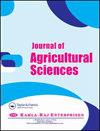The Effect of Diflufenican and Its Mixture with S-metolachlor and Metribuzin on Nitrogenase and Microbial Activity of Soil under Yellow Lupine (Lupinus luteus L.)
IF 0.7
Q3 AGRICULTURE, MULTIDISCIPLINARY
引用次数: 4
Abstract
The aim of the study was to evaluate the effect of the active substance of diflufenican and its combination with s-metolachlor or metribuzin, applied to yellow lupine, on the nitrogenase activity, the population size of selected groups of microorganisms, the activity of soil enzymes and their sensitivity to the tested preparations. All analysed preparations caused a reduction in the total number of bacteria and the number of actinobacteria and oligotrophic bacteria at the beginning of the vegetation period of yellow lupine. In the combination where diflufenican was used separately a stimulatory effect on nitrogenase activity was observed. The research revealed very high sensitivity of dehydrogenases and acid phosphatase to the soil contamination caused by application of all the tested herbicides. The dehydrogenases activity values were closely correlated with reduced populations of the groups of microorganisms. Diflufenican applied separately caused a relatively small negative effect on biological soil properties and consequently could have a smaller negative effect on soil environment contamination in comparison to other variants.双氟虫尼及其与s -甲草胺、甲曲霉嗪混用对黄羽扇豆种植土壤氮酶及微生物活性的影响
本研究的目的是评价应用于黄羽扇豆的活性物质双氟虫尼及其与s-甲草胺或甲曲霉嗪的组合对氮酶活性、选定微生物群的种群规模、土壤酶的活性及其对所试制剂的敏感性的影响。所有分析的制剂在黄羽扇豆植被期开始时都导致细菌总数和放线菌和少营养细菌数量的减少。在单独使用双氟芬尼的组合中,观察到对氮酶活性的刺激作用。研究表明,脱氢酶和酸性磷酸酶对施用除草剂引起的土壤污染具有很高的敏感性。脱氢酶活性值与微生物群数量的减少密切相关。单独施用双氟虫尼对土壤生物特性的负面影响相对较小,因此与其他变体相比,对土壤环境污染的负面影响可能较小。
本文章由计算机程序翻译,如有差异,请以英文原文为准。
求助全文
约1分钟内获得全文
求助全文
来源期刊

Journal of Agricultural Sciences
AGRICULTURE, MULTIDISCIPLINARY-
CiteScore
1.80
自引率
0.00%
发文量
0
 求助内容:
求助内容: 应助结果提醒方式:
应助结果提醒方式:


